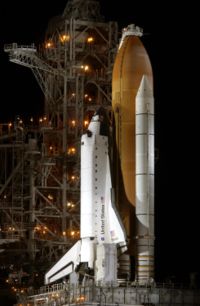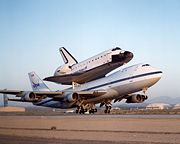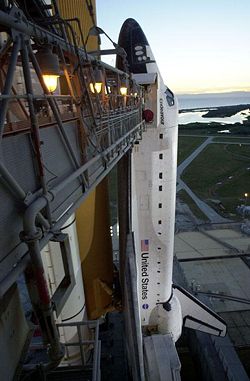Space Shuttle Endeavour
2008/9 Schools Wikipedia Selection. Related subjects: Space transport
| Endeavour OV-105 |
|
|---|---|
 Space Shuttle Endeavour on the launch pad prior to mission STS-113, November 22, 2002. |
|
| OV Designation: | OV-105 |
| Country: | United States |
| Contract award: | July 31, 1987 |
| Named after: | HM Bark Endeavour |
| First flight: | STS-49 May 7, 1992 - May 16, 1992 |
| Last flight: | STS-123 March 11, 2008 - March 26, 2008 |
| Number of missions: | 21 |
| Time spent in space: | 234.01 days |
| Number of orbits: | 3,259 |
| Distance travelled: | 136,910,237 km (73,925,614 nmi) |
| Satellites deployed: | 3 |
| Mir dockings: | 1 |
| ISS dockings: | 8 |
| Status: | Active |
Space Shuttle Endeavour ( Orbiter Vehicle Designation: OV-105) is one of the three currently operational orbiters in the Space Shuttle fleet of NASA, the space agency of the United States. (The other two are Discovery and Atlantis.) Endeavour was the fifth and final NASA space shuttle to be built.
Current status
Endeavour is currently in OPF-02, having completed a 16 day mission to the International Space Station. All three of Endeavour's Space Shuttle Main Engines have been reinstalled in preparation for either the STS-400 "Launch on Need" mission or the planned STS-126 mission.
History
The United States Congress authorized the construction of Endeavour in 1987 to replace Challenger, which was lost in an accident in 1986. Structural spares from the construction of Discovery and Atlantis, two of the three remaining operating shuttles at the time, were used in its assembly. The decision to build Endeavour was favored over refitting Enterprise on cost grounds.
Endeavour was named through a national competition involving students in elementary and secondary schools. Tallulah Falls School in Tallulah Falls, Georgia, was the winner of the secondary school competition. The orbiter is named after HM Bark Endeavour, the ship commanded by 18th century explorer James Cook; the name also honored Endeavour, the Command Module of Apollo 15. This is why the name is spelled in the British English manner, rather than the American English spelling of "Endeavor." This has caused confusion, most notably when NASA themselves misspelled a sign on the launch pad in 2007.
Endeavour was delivered by Rockwell International in May 1991 and first launched a year later, in May 1992, on STS-49. Rockwell International claimed that it had made no profit on Space Shuttle Endeavour, despite it costing $2.2 billion USD. On its first mission, it captured and redeployed the stranded INTELSAT VI communications satellite.
In 1993, it made the first service mission to the Hubble Space Telescope. Endeavour was withdrawn from service for eight months in 1997 for a retrofit, including installation of a new airlock. In December 1998, it delivered the Unity Module to the International Space Station. Endeavour completed its latest Orbiter Major Modification period, which began in December 2003, and ended on Thursday, October 6, 2005. During this time, the Orbiter received major hardware upgrades, including a new, multi-functional, electronic display system, often referred to as glass cockpit, and an advanced GPS receiver, along with safety upgrades recommended by the Columbia Accident Investigation Board (CAIB) for Shuttle return to flight after the disintegration of sister-ship Columbia during re-entry on February 1, 2003.
The STS-118 mission, the first for Endeavour following a lengthy refit, included astronaut Barbara Morgan, formerly assigned to the Educator Astronaut program, but now a full member of the Astronaut Corps, as part of the crew. Morgan was the backup for Christa McAuliffe on the ill-fated STS-51-L mission.
Upgrades and features
Endeavour features new hardware designed to improve and expand orbiter capabilities. Most of this equipment was later incorporated into the other two orbiters during out-of-service major inspection and modification programs. Endeavour's upgrades include:
- A 40-foot (12 m) diameter drag chute that is expected to reduce the orbiter's rollout distance by 1,000 to 2,000 feet (300 to 600 m).
- The plumbing and electrical connections needed for Extended Duration Orbiter (EDO) modifications to allow up to 28-day missions (although a 28-day mission has never yet been attempted; the current record is 17 days, which was set by Columbia).
- Updated avionics systems that include advanced general purpose computers, improved inertial measurement units and tactical air navigation systems, enhanced master events controllers and multiplexer-demultiplexers, a solid-state star tracker and improved nose wheel steering mechanisms.
- An improved version of the Auxiliary Power Units (APUs) that provide power to operate the Shuttle's hydraulic systems.
Modifications resulting from a 2005-2006 refit of Endeavour include:
- The Station-to-Shuttle Power Transfer System (SSPTS), which converts 8 kilowatts of DC power from the ISS main voltage of 120VDC to the orbiter bus voltage of 28VDC. This upgrade will allow Endeavour to remain on-orbit while docked at ISS for an additional 3- to 4-day duration. The corresponding power equipment was added to the ISS during the STS-116 station assembly mission, and Endeavour flew with SSPTS capability during STS-118.
Flights
Space Shuttle Endeavour has flown 20 flights, spent 219.35 days in space, completed 3,259 orbits, and flown 85,072,077 miles (136,910,237 km) in total, as of August 2007.
| # | Launch date | Designation | Launch pad | Landing location | Notes |
|---|---|---|---|---|---|
| 1 | 1992- 05-07 | STS-49 | 39-B | Edwards Air Force Base | First flight of Endeavour: Capture and redeploy Intelsat VI. First three-man EVA, longest US EVA since Apollo 17 |
| 2 | 1992- 09-12 | STS-47 | 39-B | Kennedy Space Centre | Spacelab mission J |
| 3 | 1993- 01-13 | STS-54 | 39-B | Kennedy | Deploy TDRS-F |
| 4 | 1993- 06-21 | STS-57 | 39-B | Kennedy | Spacelab experiments. Retrieve European Retrievable Carrier |
| 5 | 1993- 12-02 | STS-61 | 39-B | Kennedy | First Hubble Space Telescope service mission (HSM-1) |
| 6 | 1994- 04-09 | STS-59 | 39-A | Edwards | Space Radar Laboratory experiments |
| 7 | 1994- 09-30 | STS-68 | 39-A | Edwards | Space Radar Laboratory experiments |
| 8 | 1995- 03-02 | STS-67 | 39-A | Edwards | Spacelab Astro-2 experiments |
| 9 | 1995- 09-07 | STS-69 | 39-A | Kennedy | Wake Shield Facility and other experiments |
| 10 | 1996- 01-11 | STS-72 | 39-B | Kennedy | Retrieve Japanese Space Flyer Unit |
| 11 | 1996- 05-19 | STS-77 | 39-B | Kennedy | Spacelab experiments |
| 12 | 1998- 01-22 | STS-89 | 39-A | Kennedy | Rendezvous with Mir space station and astronaut exchange |
| 13 | 1998- 12-04 | STS-88 | 39-A | Kennedy | International Space Station assembly mission (assembled the Unity Module (Node 1), first American component of the ISS) |
| 14 | 2000- 02-11 | STS-99 | 39-A | Kennedy | Shuttle Radar Topography Mission experiments |
| 15 | 2000- 11-30 | STS-97 | 39-B | Kennedy | International Space Station assembly mission ( P6 truss segment) |
| 16 | 2001- 04-19 | STS-100 | 39-A | Edwards | International Space Station assembly mission ( Canadarm2 robotic arm and hand) |
| 17 | 2001- 12-05 | STS-108 | 39-B | Kennedy | International Space Station rendezvous and astronaut exchange ( Expedition 3/ Expedition 4) |
| 18 | 2002- 06-05 | STS-111 | 39-A | Edwards | International Space Station rendezvous and astronaut exchange ( Expedition 4/ Expedition 5) |
| 19 | 2002- 11-23 | STS-113 | 39-A | Kennedy | International Space Station assembly mission and astronaut exchange/final successful shuttle flight before the Columbia disaster ( Expedition 5/ 6 exchange; P1 truss segment assembly) |
| 20 | 2007- 08-08 | STS-118 | 39-A | Kennedy | Four spacewalks conducted . Installation of the International Space Station S5 Truss, of the Integrated Truss Structure. Carried a SPACEHAB module carrying 5,000 pounds of supplies and equipment to the International Space Station. Crew included the Educator Astronaut Barbara Morgan. Thermal tiles protecting the underside of the vehicle were damaged during launch. NASA decided not to fix this damage in-flight as it was not believed to be serious enough to result in loss of vehicle or crew. The craft landed a day early due to the possibility that Hurricane Dean would force Mission Control to evacuate. |
| 21 | 2008- 03-11 | STS-123 | 39-A | Kennedy | International Space Station assembly mission which delivered the first element of Japan's Kibo module along with the Canadian Special Purpose Dexterous Manipulator robotic arm, and the Spacelab Pallet-Deployable 1. |
| 22 | NET 2008-10-11 | STS-126 | 39-A | Kennedy | International Space Station assembly mission which will bring up a Multi-Purpose Logistics Module Leonardo, Crew rotation of Sandra Mangus For Gregory Chamitoff |
Decommissioning of Space Shuttle Endeavour

According to NASA, Space Shuttle Endeavour will be decommissioned in 2010, after 18 years of service, along with Discovery and Atlantis. NASA expects to have the Orion spacecraft ready no later than 2014. Based on the current (as of August 2007) consolidated launch manifest, Endeavour may be the last Orbiter to fly, contingent on the optional STS-133 mission to the International Space Station, which will carry the final components in the ISS assembly sequence, the EXPRESS Logistics Carrier ELC5 and ELC1, to orbit.

